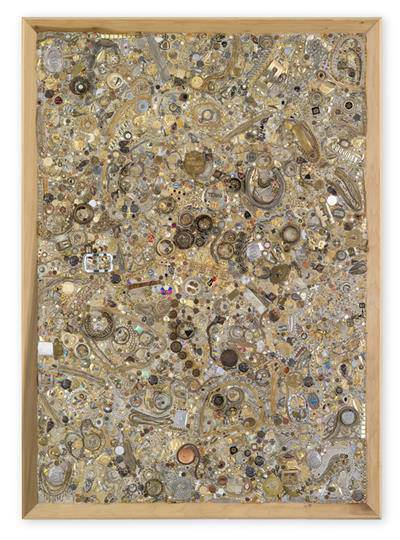
Mike Kelley
Memory Ware Flat #24, 2001
Mixed media on wood panel
215.5 x 154 x 11.8 cm / 84 7/8 x 60 5/8 x 4 5/8 in
Art © Mike Kelley Foundation for the Arts
All Rights Reserved / Licensed by VAGA, New York, NY
Private Collection
Courtesy the Foundation and Hauser & Wirth
Photo: Stefan Altenburger Photography Zürich
Mike Kelley at Hauser & Wirth New York Hauser & Wirth presents ‘Memory Ware’, the first exhibition since 2001 devoted exclusively to both the two- and three-dimensional works from the celebrated series of the same name by Mike Kelley (1954 – 2012). 3 Nov – 23 Dec 2016.]]>
Source: Hauser & Wirth New York
Over the course of his influential four-decade career, Kelley generated a remarkably diverse oeuvre in an array of mediums, conflating high and low culture, critiquing prevailing aesthetic conventions and colliding the sacred with the profane. Comprised of some 100 Memory Wares and associated works made between 2000 and 2010, the Memory Ware series occupies a prominent place in Kelley’s materially and conceptually complex output. It includes two- and three-dimensional pieces: wall works known as Memory Ware Flats and freestanding sculptures. The exhibition at Hauser & Wirth will showcase almost two dozen Memory Ware works, most on loan from museums and significant international private collections.
On view through 23 December, ‘Memory Ware’ will coincide with the release of the first ever book to document Kelley’s entire Memory Ware series. This volume, published by Hauser & Wirth Publishers in association with the Mike Kelley Foundation for the Arts, features an essay by Ralph Rugoff, Director of the Hayward Gallery, London, offering a fresh analysis of the Memory Ware series and its position within Kelley’s practice.
Ralph Rugoff on Mike Kelley’s Memory Ware Series
Mike Kelley’s Memory Ware series embodies the thematic engagement with memory-related concerns that informed the second half of the artist’s career. Beginning with such projects as “Educational Complex” (1995), a model conflating his recollections of the design of his childhood home and every school he attended, and “Categorical Imperative” (1999), a sprawling installation that re-contextualized leftover production materials from 20 years of art-making, Kelley devoted himself to exploring conventions of remembering, representing, and reconstructing the past. Fuelled by a deeply felt antipathy toward nostalgia, and incorporating references to personal, folk, and collective histories, these works were formally realized in ways that evoked tropes of modernist aesthetic practice and theory, while critically reflecting on the criteria and categories through which recent art historical memory has been forged.
Related content
Mike Kelley at Hauser & Wirth New York (exhibition, 2015)
Follow us on:


